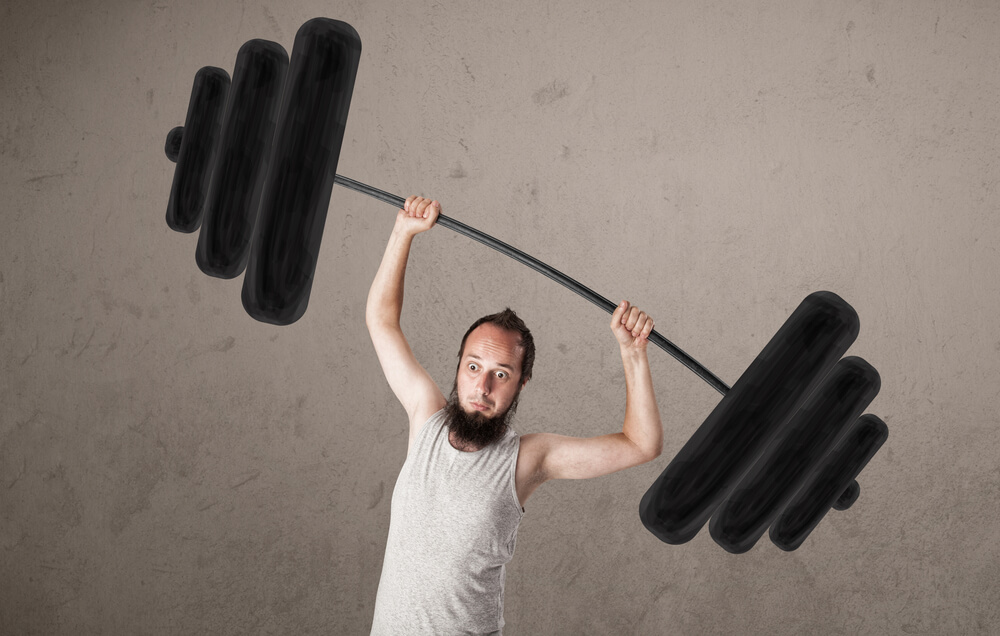
If you’ve always been skinny, you know how hard it can be to build muscle. We’ve got the tips you need to finally build the physique you want. Are you ready to get big here is your skinny guy workout plan?
You’ve always been a skinny guy, even though you hit the weights hard all the time. You eat right with good, clean proteins, plenty of veggies, and stay away from pizza and beer except for once in a while with your buddies for the big game. The only thing that you feel you are missing with your workouts is size like the trainers and the guys in the magazines.
People may tell you it’s genetic, but guess what?
That’s a bogus claim. Sure, there are certain genetic limitations, but it’s a good thing that there are ways to get around that without steroids or plastic surgery.
How do you get big?
Luckily, I have an answer for you. Three things are needed, and they can’t work unless you’re doing all three.
What are they?
You need the right diet (beer and pizza are encouraged in moderation), exercise (no kidding but your set, rep, and rest schemes need to change) and the right way to recover (supplements, sleeping, etc). We will go over each of these in length to ensure you have all the basics covered.

The Skinny Guy Diet
Okay, this is the hardest part. The tough part about it is eating enough food to make sure you grow. In a nutshell, you should always have something in your hand. In order for you to grow, you need at least 2 grams of carbs per pound of bodyweight in a day. For a 200-pound man, that would mean 400 grams of carbs in a single day.
You have to ask yourself how much protein do you need?
In addition, you need at least 1 gram of protein per pound of bodyweight in a day, but I recommend more. Again, for a 200-pound man, that would mean at least 200 grams of protein in a single day (I advise shooting for 1.5 grams per pound).
As for fat, aim for 0.25 to 0.75 grams per pound of bodyweight. So getting back to the 200-pound man example, you need to consume between 50 to 150 grams of fat per day.
There are a few more rules when it comes to the dieting plan. For one thing, there are a few things to stay away from. You should try to stay away from wheat.
Why?
Simple, because the wheat protein, gluten, literally clogs your intestines and prevents you from absorbing the nutrients you need to get big. Dairy should also be avoided whenever possible, just because it can give you the runs and you can’t be eliminating all of that food within minutes of eating it and expect to get bigger.
When it comes to sources for these nutrients and their amounts, hit the local Costco and pick up a bunch of chicken (it should make up about 50% of the protein sources you buy), some beef (around 30% of the haul) and the rest is up to you. You can have pork, fish, turkey, duck or whatever you want.
As for veggies, definitely have some leafy greens like spinach, kale, Swiss chard, collard greens, etc. For other veggies, you should stick to sweet, starchy ones like carrots, onions and different roots (celery root, horseradish root, etc.). Carb sources should include white rice (brown is too hard to digest), potatoes (both sweet and white potatoes work), oats or oatmeal and granola.

Skinny Guy Workout Plan
This is the fun part. Let’s call it the skinny guy workout. The main point of this part for the workout is to be consistent. That simply means you should be sticking to the plan before you go do stuff you consider fun. All the workouts in this skinny guy workout should be full body (I will include a few for you here for ideas) and based on compound (multi-joint) lifts.
Hit the gym four days a week and you will be fine and you can hit your workout plan for skinny guys.
Note: Days 1 and 3 will be focused on pulls. Meanwhile, days 2 and 4 will be bench and squat days. Unfortunately, you have to work your legs to get big and there is science to back it up. Hitting your legs with either squats or deadlifts causes a sharp increase in blood testosterone, which helps you build muscle.
Also, it’s a good idea to invest in a few sessions with a weightlifting coach so they can teach you the basics of how to do Olympic lifts. If you don’t want to do that, then stick to the first four workouts listed. If you decide to learn the basics about Olympic lifts, then the second four workouts are for you.
Here’s a fair warning: These workouts, in the beginning, will make you feel like you got hit by a truck.
It’s a lot of heavy weight and plenty of moves, but done correctly and with proper recovery, this program will get you big, and that’s as close to a promise as it gets. However, it is on you not to do things halfway or decide you are going to lift lighter one day. In other words, if in a year’s time you find that it did not work for you, think long and hard about whether you gave it 100% every day.
Directions: Do all the moves for the prescribed sets and reps in sequence with no longer than 90 seconds rest between sets.
Workouts Without Olympic Lifts
Workout 1
Plank 2 minutes
Sumo Deadlift 5×5
Barbell Good Morning* 4×6
Romanian Deadlift (RDL) 4×5
Bent-Over Row 4×8
Chin-up 4x as many reps as possible (AMRAP)
Inverted Row 4×6 with a plate on your chest
Wide-Grip Lat Pulldown 4×12
*Use a light weight due to the strain this move puts on your lower back.
Workout 2
Plank 2 minutes
Back Squat 4×5
Front Squat 4×5
Bulgarian Split Squat 3×6 each side
Barbell Bench Press 5×5
Close-Grip Incline Press 4×8
Dumbbell Overhead Press* 4×6
*Always perform standing unless otherwise noted.
Workout 3
Plank 2 minutes
Conventional Deadlift 5×5
Glute-Ham Raise 4×6
Dumbbell Single-Leg RDL 4×5 each side
Wide-Grip Pull-up 4xAMRAP
Dumbbell Row 4×6 each side
45 Degree Lat Pulldown 4×8
Workout 4
Plank 2 minutes
Front Squat 5×5
Zercher Squat 4×6
Reverse Lunge 4×6 each side
Neutral Grip Dumbbell Incline Press 5×5
Close Grip Press 4×6
Barbell Overhead Press 4×5
Workouts With Olympic Lifts
Workout 1
Plank 2 minutes
Power Clean 4×3
Clean Pull 4×3
Sumo Deadlift 5×5
Single-Leg RDL 3×6
Wide-Grip Pull-up 4xAMRAP
Bent-Over Row 4×6
Face Pull 3×12
Workout 2
Plank 2 minutes
Push Press Walkout 4×4
Back Squat 4×5
Front Squat 4×5
Elevated Split-Squat 3×5 each side
Flat Barbell Press 4×5
Dumbbell Incline Press 4×8
Band Shoulder Press 3×6
Workout 3
Plank 2 minutes
High Pull + Hang Clean 4x(3+2)
Snatch Pull 4×3
Conventional Deadlift 4×5
Good Morning* 4×6
Weighted Chin-up 4×5
Inverted Row w/ pause 4×6
Band Pull Apart 4×12
Workout 4
Plank 2 minutes
Drop Snatch 4×3
Front Squat 4×5
Barbell Reverse Lunge 4×5 each side
DB Lateral Step-up 4×5 each side
Close Grip Incline Press 4×5
DB Floor Press w/ pause 4×8
BB Overhead Press 3×6

Workout For Skinny Guys Final Tips
A few more points and you’ll be good to go. Every four weeks or so, scale back the weights or the volume a little bit (make it lighter or do a few less sets).
Why?
This will allow your body to return to normal – almost like a reset for your nervous system.
The heavier you can lift over time, the more muscle fiber you’ll recruit with each movement and the bigger you’ll get. However, this is not possible without the scale back or de-load process as it’s called in the powerlifting community (see the size of those guys?). Without that scale back, your nervous system will be all jacked up, all the time, which will lead to adrenal fatigue. And you do not want that!
Why?
It means decreases in performance and overall decreases in size.
Don’t let that happen!
Also, you should be doing a plank in every workout for 2 minutes at the start.
Why?
As strength coaches for the elite would say, “strength through stability (of the core).” The stronger your core is, the heavier you can lift and that will bring you towards your goal. Feel free to do as much additional core training as you like. Also, the eventual goal with the plank is to be able to hold it for 5 minutes, which is incredibly hard. I’d say increase that 2 minutes by 30 seconds every four weeks or so.
You Need Your Recovery Time
This is the part everyone forgets. Recovery is arguably more important than the workouts you do. You can work out every day until you’re blue in the face, but if you are not recovering properly, you won’t progress, or worse yet, end up with something like rhabdomyolysis. It’s worse than it sounds.
So how do you recover?
There are a few things to keep in mind: Sleep. Remember when your mother used to tell you that you grow while you are asleep?
With muscles, it’s true!
When the body shuts down for the night, the parasympathetic nervous system (your brakes) slows everything down, but increases intestinal and glandular activity. To put it simply, that means the anabolic hormones (the ones that build things) such as testosterone, IGF-I and growth hormone are released into the blood and help you rebuild bigger and stronger.
You Need To Eat Right
Everyone knows it is important to have protein after you work out, but an often forgotten element of the best post workout meal or shake are the carbs. When you work out, your body draws its energy from glycogen. This is derived from carbs then stored in the muscles and the liver.
After you’re done working out (ever hit the wall during a lift?), the muscle glycogen stores are depleted and your body will start to draw it from the liver (bad news, because the liver uses it to make hormones like testosterone), so it’s important to eat carbs to replenish what you’ve lost.
So in that best tasting protein shake, make sure to get some honey, fruit or whatever else for the carbs. As a bonus, you get a little insulin (an anabolic hormone that processes sugars from carbs) spike, which helps in the size dilemma.
You Should Consider Some Supplements
Now I could give you the same nonsense the salesman in the health and nutrition store does when he tries to sell you everything under the sun, but I won’t. There’s stuff that works and stuff that doesn’t.
You’ll need to research the best supplements for weight loss and muscle gain, but here are a few that stick out…
L-glutamine (an amino acid, usually sold in powder form) promotes gut health. That means you will digest and absorb food and nutrients better, and it also helps a little with the soreness from working out.
Caffeine or caffeine pills (both pre-workout and on recovery days) speeds everything up, including the recovery process. Also, pre-workout supplements will usually contain a little creatine. This is an essential part of the phosphocreatine energy system, which is vital for muscle contraction, especially when lifting heavy or moving fast.
L-leucine has been shown to increase protein synthesis (speed up muscle growth). That, in conjunction with HMB (beta-Hydroxy beta-methyl butyric acid, if you were curious), which has been shown to be an extremely powerful anti-catabolic agent (it prevents muscle breakdown), could make a difference.
Lastly, a protein supplement is acceptable when you can’t get solid food – at least 40 grams post workout.
Conclusion
So there you have it, your complete guide to getting big. It likely seems like a lot, but it will all become part of the routine and you’ll know it like the back of your hand in no time. Just remember to give it your all on everything, including the skinny guy workout and recovery.
Happy lifting!
By Michael Schletter, CSCS*D, NSCA-CPT*D
Latest posts by Terry M (see all)
- Garage Gyms - Aug 1, 2018
- Kettlebells – Why They Should Be Added To Your Routine. - Jul 24, 2018
- Weight Belts: What Are They Really For? - May 31, 2018









